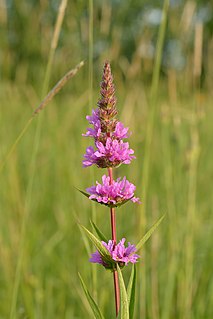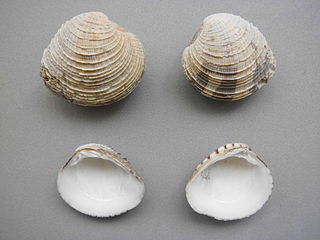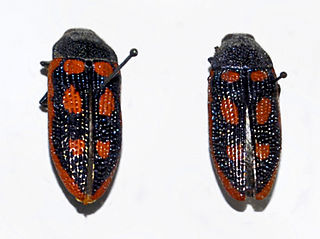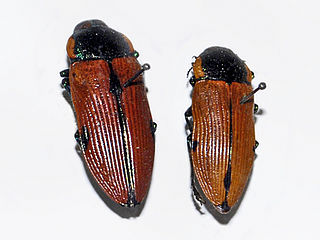
Lythrum salicaria, or purple loosestrife, is a flowering plant belonging to the family Lythraceae. It should not be confused with other plants sharing the name loosestrife that are members of the family Primulaceae. Other names include spiked loosestrife and purple lythrum.

The longhorn beetles are a cosmopolitan family of beetles, typically characterized by extremely long antennae, which are often as long as or longer than the beetle's body. In various members of the family, however, the antennae are quite short and such species can be difficult to distinguish from related beetle families such as the Chrysomelidae. The family is large, with over 26,000 species described, slightly more than half from the Eastern Hemisphere. Several are serious pests. The larvae, called roundheaded borers, bore into wood, where they can cause extensive damage to either living trees or untreated lumber. A number of species mimic ants, bees, and wasps, though a majority of species are cryptically colored. The rare titan beetle from northeastern South America is often considered the largest insect, with a maximum known body length of just over 16.7 cm (6.6 in). The scientific name of this beetle family goes back to a figure from Greek mythology: after an argument with nymphs, the shepherd Cerambus was transformed into a large beetle with horns.

The Tuamotu sandpiper is an endangered member of the large wader family Scolopacidae, that is endemic to the Tuamotu Islands in French Polynesia. It is sometimes placed in the monotypic genus Aechmorhynchus. A native name, apparently in the Tuamotuan language, is kivi-kivi.

The family Oedemeridae is a cosmopolitan group of beetles commonly known as false blister beetles, though some recent authors have coined the name pollen-feeding beetles. There are some 100 genera and 1,500 species in the family, mostly associated with rotting wood as larvae, though adults are quite common on flowers.

Cleridae are a family of beetles of the superfamily Cleroidea. They are commonly known as checkered beetles. The family Cleridae has a worldwide distribution, and a variety of habitats and feeding preferences.

Chione cancellata, is a species of medium-sized saltwater clam, a marine bivalve mollusc in the family Veneridae, the venus clams.
Chlorocypha cancellata is a species of damselfly in the family Chlorocyphidae. It is found in Cameroon, the Republic of the Congo, the Democratic Republic of the Congo, Equatorial Guinea, Gabon, Guinea, Nigeria, and Uganda. Its natural habitats are subtropical or tropical moist lowland forests and rivers.

Bursaria spinosa is a small tree or shrub in the family Pittosporaceae. The species occurs mainly in the eastern and southern half of Australia and not in Western Australia and the Northern Territory. Reaching 10 m (35 ft) high, it bears fragrant white flowers at any time of year but particularly in summer. A common understory shrub of eucalyptus woodland, it colonises disturbed areas and fallow farmland. It is an important food plant for several species of butterflies and moths, particularly those of the genus Paralucia, and native bees.

The Christmas sandpiper was a small shorebird. It became extinct some time in the first half of the 19th century. It was endemic to Kiritimati Island in Kiribati.

Coccinellidae is a widespread family of small beetles ranging in size from 0.8 to 18 mm. The family is commonly known as ladybugs in North America, and ladybirds in Britain and other parts of the English-speaking world. Entomologists widely prefer the names ladybird beetles or lady beetles as these insects are not classified as true bugs.

Bivetiella cancellata is a species of sea snail, a marine gastropod mollusk in the family Cancellariidae, the nutmeg snails.

Temognatha alternata is endemic to Queensland, Australia. Little is known of this spectacular beetle which has never been formally described, as the name is taken from that given by Lumholtz without any description.

Stigmodera is a genus of beetles in the family Buprestidae, the jewel beetles. It is a large genus that some authors divide into three separate genera. Others keep them together, making Stigmodera a genus of some 550 species. Most are native to Australia and a few occur in New Guinea.
Cynthidia is a genus of beetles in the family Carabidae, containing the following species:

Temognatha alternata, commonly known as the variable jewel beetle, is a beetle of the family Buprestidae.
Sangaris cancellata is a species of beetle in the family Cerambycidae. It was described by Bates in 1881. It is known from Bolivia.
Stigmodera sanguinosa, is a species of beetle in the family Buprestidae found throughout the southern parts of Australia.
Glenea cancellata is a species of beetle in the family Cerambycidae. It was described by James Thomson in 1865.
Megetra cancellata is a species of blister beetle in the family Meloidae. It is found in Central America and North America.














